When we received Sony’s press release announcing the launch of the new 200Hz Bravia Z5500 LCD televisions a few months ago, we naturally assumed that its predecessor (the Z4500 range) would be slowly phased out. We couldn’t be more wrong: Sony has decided to continue selling the Z4500 series as a cheaper alternative alongside the Bravia Z5500 range. Having already tested the 40-inch version of the Z4500 around this time last year, we hope we can offer you a definitive and unbiased account of any visible improvements (and/ or cutbacks) in today’s review of the Sony KDL40Z5500 HDTV.
Note: The specific model we tested was the Sony KDL40Z5500U (denoting the 3-pin plug United Kingdom version) which may be listed as Sony KDL-40Z5500 or Sony KDL40Z5500 by retailers such as John Lewis, Comet, Currys, Amazon or Dixons. These terms may be used interchangeably throughout this review to refer to the same model.
Design
The Sony KDL40Z5500 sees a slight departure in aesthetic stance compared to previous high-end Sony LCD TVs. The classy (if somewhat extravagant) “floating glass” / “suspended-in-air” design which adorned the Bravia X and Z series over the last few years is nowhere to be seen. Instead, minimalism seems to be the order of the day here: the mildly reflective LCD screen is framed by a deep charcoal grey bezel measuring less than 3cm thick on each side, giving the Sony KDL40Z5500 a truly compact and refined appearance.
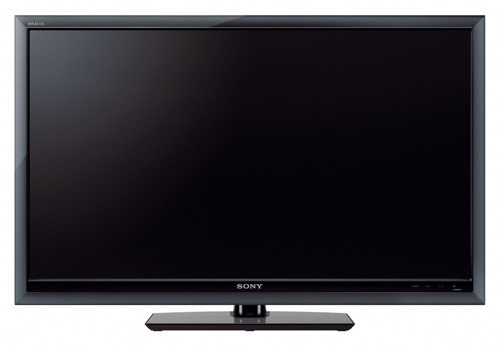
Unfortunately this degree of compactness does come at a price: the television’s internal speakers have had to be repositioned to a down-firing alignment which would inevitably impair stereo imaging, soundstage and audio resolution. Coupled with the lack of a separate woofer (the Z4500 had one), the acoustic performance of the Sony KDL40Z5500 LCD HDTV can only be described as downright disappointing.
An illuminated Sony logo (which can be switched off) sits centrally along the bottom border of the panel. The Sony KDL40Z5500 LCD TV comes with a swivelling pedestal stand that is packaged separately inside the shipping box. The stand’s rectangular base dons a charcoal grey coating which perfectly matches the bezel.
Connections
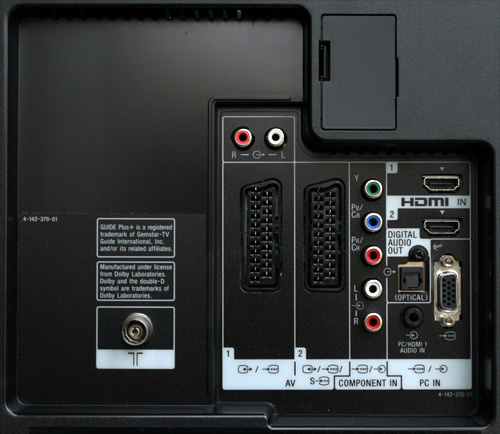 |
| Rear: 2 x HDMI, VGA, component, 2 x Scarts, aerial, digital & analogue audio outs |
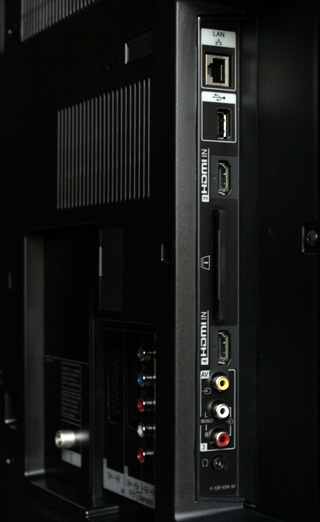 |
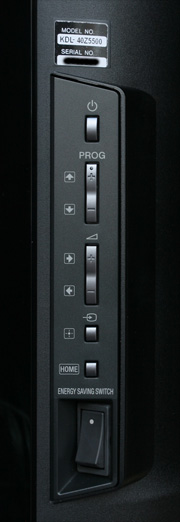 |
| Side: 2 x HDMI, USB, CI slot, comp, LAN, headphone | Panel buttons & energy switch* |
* An energy-saving switch is conveniently placed at the side of the LCD panel. Flipping this switch turns the Sony KDL40Z5500 off completely – as if you’re pulling the TV’s plug from the power socket – to further cut down on the already frugal power consumption in standby mode (<1 W).
Operation
The KDL40Z5500’s XMB-based user menu, EPG and Applicast functionalities are essentially the same as those found on the KDL40W5500, and we’ve seen the neon-blue-backlit remote control before when we tested the KDL40Z4500. Please refer to the relevant sections in our respective reviews if you need more details.
Calibration
Greyscale
Out of the box, engaging the [Cinema] / [Theatre] mode on the Sony KDL40Z5500 – with its default [Colour Temperature] setting of “Warm 2” – yielded the greyscale closest to D65 industry standard:
 |
| Pre-calibration CCT with [Cinema] mode & “Warm 2? [Colour Temperature] |
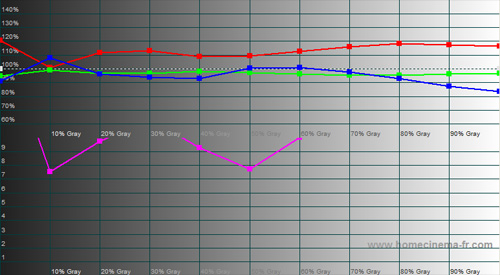 |
| Pre-calibration RGB tracking & delta errors |
The obvious issue to rectify here is the red channel predominance. After adjusting the RGB cuts and gains in the [White Balance] submenu, we obtained the following result:
 |
| CCT after greyscale calibration in [Cinema] mode |
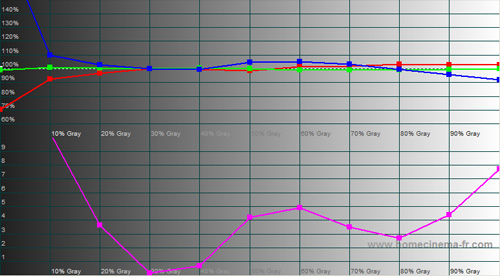 |
| RGB tracking and delta errors (dEs) after greyscale calibration |
Astute readers will notice that the calibrated greyscale on the Sony KDL40Z5500 LCD TV did not track as well as that on the KDL40W5500. Specifically, the problem we encountered was that the blue channel clipped prematurely at the top-end (above 75% stimulus) once we increased the [Contrast] value beyond 65. This suggests that a different LCD panel – perhaps one that can handle the rigour of 200Hz motion-compensated frame interpolation – was implemented on the Sony KDL40Z5500 HDTV.
Of course, we could flatten the greyscale somewhat by setting [Contrast] to 65 or below. However, in order to maintain top-end luminance (so as to avoid the overall picture looking too dark), we would also need to bump up [Backlight]. The ensuing rise in black level – not to mention the increased conspicuity of backlight unevenness/ clouding – makes this a far from satisfactory solution.
Colour
This is one area where the Sony KDL40Z5500 trumped the W5500, which is not surprising given the inclusion of WCG-CCFL backlight (as distinct from CCFL only on the W5500). Although the Sony KDL40Z5500 does not offer any form of colour management system (CMS), its colour points and decoding in “Standard” [Colour Space] pretty much clicked into place once greyscale was calibrated:
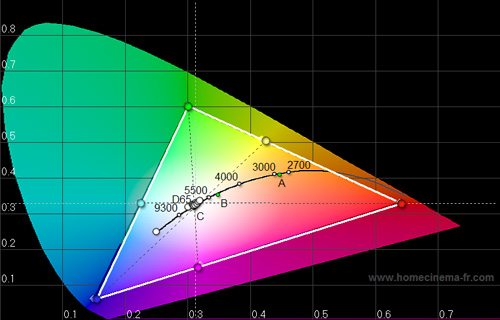 |
| Post-calibration CIE chart with reference to HD Rec. 709 |
On the other hand, setting [Colour Space] to “Wide” made the colours more vivid but less accurate. Increasing [Live Colour] from “Low” to “High” only served to progressively exaggerate these colour inaccuracies:
![[Colour Space] Wide](/news/wp-content/uploads/2018/04/hdtv_Sony-KDL40Z5500_cie-wide.jpg) |
![[Live Colour] High](/news/wp-content/uploads/2018/04/hdtv_Sony-KDL40Z5500_cie-high.jpg) |
| [Colour Space] “Wide” | [Live Colour] “High” |
Benchmark Test Results
| Dead pixels | None |
| Screen uniformity | Clouding and backlight bleed reducible to negligible levels |
| Overscanning on HDMI | 0% with [Display Area] set to “Full Pixel“ |
| Blacker than black | Passed |
| Black level | Excellent (0.06 cd/m2 calibrated) |
| Black level retention | Stable in [Cinema] / [Theatre] mode |
| Primary chromaticities | Excellent in “Standard” [Colour Space] |
| Scaling | Above average |
| Video mode deinterlacing | Average; limited jaggies reduction |
| Film mode deinterlacing | Passed 3:2 cadence in 480i; and 2:2 in 576i |
| Viewing angle | 90° |
| Motion resolution | [Motionflow] “Standard” and “High“: 1080; “Off”: 300 |
| Digital noise reduction | A touch noisy in some off-air broadcasts |
| Sharpness | Defeatable edge enhancement |
| 1080p/24 capability (PS3) | Accepts 1080p/24 video signal; no telecine judder |
| Input lag (rel. to Samsung F96) | 20-30ms over VGA or in [Game Mode]; 50-80ms otherwise |
Power Consumption
| Default “Standard” [Picture Mode] | 137 watts |
| Calibrated [Cinema]/[Theatre] mode | 104 watts |
| Standby | 13 watts with [Quick Start] engaged; <1 watt otherwise |
Picture Performance
Black Level
It would be harsh not to classify the black-level performance on the Sony KDL40Z5500 as excellent, although strictly speaking the Samsung B650/ 750 range and Sony’s own W5500 series of LCD televisions remained a hair darker both in objective measurement and subjective viewing. With [Adv. Contrast Enhancer] activated, the black level on the Sony KDL40Z5500 can be lowered even further (to an awesome 0.01 cd/m2) through some dynamic dimming gimmickry, but this is not advisable for critical viewing due to black level fluctuation and the ensuing compromise in shadow detail and bright highlights.
Screen/ Backlight Uniformity
Out of the box, the KDL40Z5500 exhibited the usual amount of clouding/ mura we’ve come to associate with recent Sony large-screen LCD TVs, though this can be attenuated to unobtrusive levels via proper calibration. Regardless of whether calibration had been performed or not, the backlight unevenness on the Sony KDL40Z5500 was aggravated during off-axis viewing to go with the unavoidable viewing-angle-related washout in black level, contrast and colour typical of LCD panels. Plasma television remains the indisputable number one choice for consumers wanting a flat panel HDTV with wide viewing angles and near-perfect screen uniformity.
Motion Resolution
Using Chapter 31 of the “FPD Benchmark Software For Professional” test disc as our reference, baseline motion resolution on the Sony KDL40Z5500 HDTV without engaging [Motionflow] was measured to be 300. Setting [Motionflow] to “Standard” was enough to boost motion resolution to 1080, tying the record previously set by the Bravia Z4500 in the LCD category.
Standard Definition
Just like all the Sony Bravia LCD televisions we’ve tested to date, the Sony KDL40Z5500 did not do too well in the video-mode deinterlacing tests found within the HQV Benchmark disc. Jaggies remained clearly visible particularly in the bouncing bars test pattern, indicating a deficiency in Sony’s implementation of motion-adaptive directional filtering.
The effect is not subtle when it comes to real-life viewing: the Sony KDL40Z5500 exhibited more noticeable serration on diagonal lines (for example football pitch markings) in video-based material than comparable Samsungs. And while the TV’s internal Freeview tuner presented sufficient detail to satisfy, it also tended to accentuate digital block noise, which can be very unforgiving for low bit-rate programmes.
On a positive note, blacks were formidable, and flesh tone looked supremely realistic as a result of the KDL40Z5500’s accurate colour rendition which was free of red push. The Sony KDL40Z5500 LCD television also successfully detected and processed 3:2 cadence over 480i, and more importantly for us Europeans, 2:2 over 576i. This means that film-based content like movies and dramas shot on film will largely be rid of distracting deinterlacing artefacts such as jaggies, moire and line twitter.
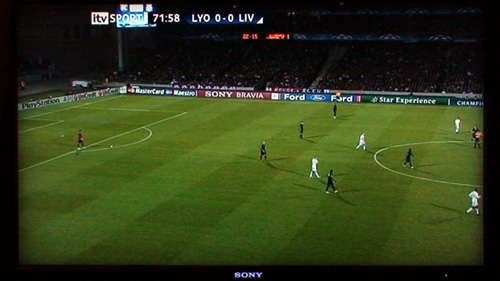
High Definition
1080p high-def images did not disappoint on the Sony KDL40Z5500 HD TV, thanks to the set’s deep blacks, accurate colours, and exquisitely sharp detail afforded by 1:1 pixel mapping without overscan. 24p video signal was also handled flawlessly without any sign of telecine judder.
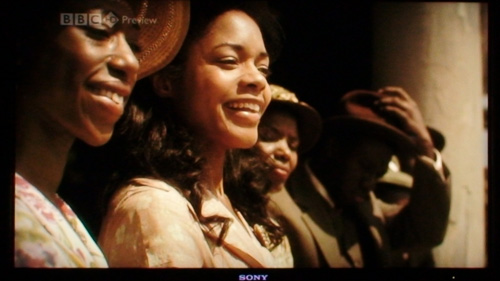
Engaging [Motionflow] “Standard” did introduce a whiff of video-like effect to Blu-ray movies, but to be fair Sony’s Motionflow system remains one of the cleanest and least offensive MCFI (motion-compensated frame interpolation) implementations among major brands (in our opinion bettered only by the 2009 Samsungs which offer separate dejudder and deblur adjustments).
Console Gaming
Input lag on the Sony KDL40Z5500 LCD TV was on the whole higher than that on the Z4500. On the KDL40Z5500, we measured its input lag to be 50-80ms slower than our resident Samsung F96 reference. This could be cut down to 20-30ms (vs the Samsung F96) either by engaging [Game Mode] through the [Scene Select] submenu, or by connecting with VGA [Graphics Mode].
While whether or not your gaming performance will be affected depends on your individual sensitivity and the reflexes demanded by the particular game, there’s no denying that the Sony KDL40Z5500 is not as appealing as last year’s Z4500 to lag-sensitive gamers who crave as little delay as possible between game controller and on-screen action.
Conclusion
For critical viewing, the Sony KDL40Z5500 HDTV delivers at least 2 tangible benefits over the Z4500:
- Inclusion of user-accessible white balance controls, which means that we need not break into the service menu to calibrate greyscale closer to D65; and
- Eradication of undefeatable edge enhancement on 1080 content.
However, sound quality on the Sony KDL40Z5500 has dropped a notch, and its input lag has creeped up compared to the Z4500. While these flaws do not stop the Sony KDL40Z5500 from earning a “Highly Recommended” award from us, you might want to take them into consideration when choosing between the Z5500 and Z4500.

Calibrated Settings
Here are the final settings for the Sony KDL40Z5500 review sample we tested, calibrated from a HD source using HDMI input in accordance with video industry standards in a dimly-lit environment suitable for critical viewing. While these settings resulted in video-standard-compliant images on our set, they may not do so for yours due to unavoidable differences in input source, viewing environment, firmware versions, and baseline service menu levels. However, if you do not have the resources to perform proper calibration on your Sony KDL40Z5500 HDTV, these settings should serve as a good starting point for achieving picture quality that comes close to the standard used in film studios. Still, you should at least use a basic calibration disc like the Digital Video Essentials Blu-Ray to set the black level [Brightness] correctly on your Sony KDL40Z5500.
|
|
|
|
|
|
|
|
|
|
|
|
|
|
|
|
|
|
|
|
|
|
|
|
|
|
|
|
|
|
|
|
|
|
|
|
|
|
|
|
|
|
|
|
|
|
|
|
|
|
|
|
|
|
|
|
|
|
|
|
|
|
|
|
|
|
|
|
|
|
|
|
|
|
|
|
|
|
|
|
|
|
|
|
|
|
|
|
|
|
|
|
|
|
|
|
|
|
|
|
|
|
|
|
|
|
|
|
|
|
|
|
|
|
|
|
|
|
|
|
|
|
|
|
|
|
|
|
|
|
|
|
|
|
|
|
|
|
|
|
|
|
|
|
|
|
|
|
|
|
* Backlight can be increased as necessary in a brighter viewing environment (especially during daytime) to boost shadow detail and peak brightness.
** For standard definition, use [Film Mode] “Auto 2“.
Please Support Us
If you find the above settings useful or simply want to thank us for the hard work we put into our in-depth reviews, feel free send a couple of quid our way, which will be used to fund more HDTV purchases:


thanks for the excellent reviews
just picked up this tv (40z5500) yesterday and was wondering if the improvements
in calibration you carried out would be similar to those setting changes you specified
in your review of the 40w5500
greetings from sydney
thanks for the review. I have the 40Z5500 for two months now and happy with it. I hope that you will give your settings because for now I use the calibrated settings of another site but something is missing.
You were away a long time…nice to see you’re back.
THANK GOD YOU ARE BACK VINCENT!
I missed a review of yours so much I cannot even tell! I do not trust anybody else! Please review Philips 40PFL9704 or Samsun LE40B8000!!! I am struggling to decide between these two TV sets!
get the philips its light years ahead , , and the closest ive ever seen a lcd come to matching kuro range and thats saying something ……………..
Thx for another excellent review Vincent !!
Glad to see you back on track you are missed its been a long wait.
To be honest this site is the only one out there that has great reviews, there is no site or magazine even close.
So thx for all the great work you/others put down on this site, its a pure joy to read every review.
Good review, as always! Happy to see you’re back, Vincent! ;)
Hi Vincent, another excellent review, thanks very much.
I echo the request for your settings. Would be VERY grateful if you could publish these so we can all enjoy this set to its fullest potential.
THANKS again!
Hi Vincent
I’ve just bought the 40Z5500 after my samsung LE32R74BD gave up the ghost after a mere 3yrs!!
Out of the box I found the Sony an joy to set up and it looks stunning. Colours are natural, however a little dark at times. I’ve adjusted the back light & brightness, but it had undesired affects elsewhere.
If you get a chance, can you post your settings so i can give this TV best it deserves.
Thanks for the review, good stuff as always :)
Welcome back after your long absence – great review as always.
Purchased this set a while go, after some fiddling about I’ve got it look OK so I have been eagerly anticipating your calibration settings – please publish them soon :-)
well how come the Z5500 score low in upscaling,considering the cheaper W5500 scored very good,is it a typo
Great review!
Could you please post your calibrated settings?
And please tell me if you are experiencing problems with the 200hz settings that makes the picture lagg every 10 seconds or so, as if the motionflow can´t quite keep up. I experience this problem no matter if the source is digital or analog, with fast or slow panning camera action.
Thanks a lot for taking your time!
PS: it is priceless what you are doing with this site for us tech savvy…
Why is this review short? Compared to other reviews this one is really short, and it doesnt give any information about this tv’s sd performance? I am dissapointed..
great to see some more reviews coming through, like francesco i only trust your calibration d65 results, i am gagging for a review of the sharp le46700 led with reccommended picture settings, how about it vincent.
Hi Vincent
If I have MotionFlow set to standard even, every now and then I get some lag just like Sasha said, it’s like a mini fast forward every now and then, a real pain. Did you see any of this? At the moment I just have it hooked up to an old Sky+ box, so not the greatest source in the world I admit.
Can you let us know all your settings please? Would be great
thank you
http://www.dday.it/redazione/220/DDay-The-Best-Gaming-TV-Test.html#pagina-1
im confused……
Thanks for this. But please do post all your settings. I am experiencing posterisation effect , which I did not expect from this TV and can’t seem to correct. Facial highlights like forehead, bridge of nose and cheekbones burn out, outlined by greenish tinges.
Examples of my problem here: try that address again (typo in the one above)
http://members.iinet.net.au/~lenilelu
I was wondering if this television is the same as the XBR version in the US. Both are 200/240 Hz. The given calibrated settings voor the XBR work well on mine 40Z5500. Do they have the same panel? But the calibrated whitebalance leaves somthing to be desired. I am very curiose about your final findings.
I bought it several days ago. Rather good. The screen is a little to reflecting if you ask me.We watch in a room with normal light, not dimmed. I see that people ask for calibrated settings. Do you have to purchase these by making a donation?
Thank you every one for your kind words… glad to be back as well. Calibrated settings have now been added to the end of the review.
Warmest regards
Vincent
Nice. Made a donation, just saying thanks.
I am new to the LCD and Plasma world having and I am torn between the Sony 40Z5500 and the Panasonic TX-P42V10. I am likely to spend about 50% if the time watchign SD through Sky, 35% DVD’s and some Blu-Ray and 15% Xbox. The room is reasonably large and well lit (2 smallish windows and french doors) but we have blinds and curtains. Most of my viewing is in the evening anyway. The TV will be at an angle and not sitting directly in front of it (if that matters).
Other forums have tended to sway me towards the Panasonic and then one pops up which makes me question which is best for me. I was also thinking that as much as I love Sony products for the difference in price I can add a media system. I am swayed by these later models compared to older ones because of the DNLA (or is that another gimmick?).
Is there really a great deal of difference between the two? Which is best suited to me?
I love this and other reviews.Its technical and un bias! And unlike what Hifi reviews where they speak like a advert
These reviews on this website are how all HD TV should be reviewed
Hi, i was wondering where do i change the 200hz to 100hz or lower for gaming purposes, i have a ps3 and i want to reduce the lag time.
thanks!
Thank you Vincent, calibrated settings posted just in time for the arrival of my 40z5800 (freesat version). This set performs superbly with HD material but as per review SD content is only average. Overall picture quality seems a litlle lower than my 40×3500. The colours are a little too saturated for my personal liking (compared to x355 using Vincents settings for that model) but colour setting at 57 as per Vincent settings also gives the most accurate set up when using test material from Video Essentials DVD. I am sur after a few weeks I will stop constantly comparing the two sets!
After a lifetime of Panasonics I decided to go for the Sony KDL 40Z5800. This was a big mistake. I have found the colours in SD very wishy-washy, despite using your calibration. The biggest disappointment however, is the viewing angle. You do not have to stray very far from a head on view before the colours start to fade. The set is being replaced with a Panasonic 37″ G15.
I recently bought this 40Z5500, and I don’t like it.
The viewing angle is a big problem. At 10 or 20 degrees the black turns into grey and the other colors start to fade.
A few day ago, I came across a 40Z5500 in a store (other then where I bought it), and I tried to compare it to mine. I changed the settings in the store so I really could compare. This set was perfect. At almost 90 degrees viewing angle, the image stayed nearly perfect.
I talked to the sales person, and he knew this was a known issue.
So apparently, this set is sold with 2 different panel types inside. And I seem to have bought the wrong one (were I bought it, I never noticed this on the demo model)
I’m still having issues setting mine up. Vincent’s settings don’t work for me. I still can’t get a satisfactory skin tone and also have the same problem as DJohn and ED. Is it possible I have a dud? Is backlight bleed noticeable for others? I see it clearly on any black screen and while it’s not noticeable in most program content I wonder if the backilight bleed is cuasing the viewing angle problem and inability to get a satisfactory set up?
Im having the same problems it sounds as you iicapn just bought mine in december i already returned my first one and now the second one has the same backlight shadowing in certain areas of the screen. Now that I have seen it i cant stop looking at it.
Dear Vincent
Thanks for your great reviw.
I have just bought a Sony 40Z5500. the picture is perfect. however I noticed that the borders of the display don’t have the same brightness as the middle. the brightness at sides are lower. Is it natural?
Dear Vincent, others,
thanks from me also. After following this site for ages I finally decided to buy this model and throw out my old 4:3 Sony Vesa. I would like to share my experience and have one question.
About the viewing angle: in normal scenes, the blacks are just fine from dead straight in front of the set to I would say 20 degrees to either site. From 20 to 45 degrees it becomes slightly noticeable but not distracting, beyond that it looks increasingly washed out. (but at that angle I am standing in my kitchen, being just glad I can still follow whats going on).
Screen uniformity isnt perfect, although I can hardly ever descern any clouding in blacks, even at brightness=7 and power save=low. However, I do regularly notice the brightess falloff at the sides of the screen. The outer 2 inches are darker. This is perhaps best displayed by the image of the football field above, although on my set the effect seems a little less obtrusive.
The sound is a bit thin and lacks some bass, but I only really miss this when watching movies or music, in which cases I tend to turn on my stereo anyway.
I also have a question. During the first minutes of watching TV the remote control is not so responsive and sometimes the TV just “doesn’t listen”, as if the it is still booting in the backround or something. The buttons on the side of the case do respond. Anyone experiencing this?
Just to be clear: I love this set. If you are a total perfectionist you may not forgive some of the above, but I do. It looks stunning and delivers all the quality I need.
Pieter
Well, after a long struggle and a warranty call, my set now has a new board in it somewhere and is producing a quality picture. At last!
a really great review, thanks for that.. but I wonder if you are going to review the Sony X4500 with the LED-RGB Backlight ? Or is there allready a review and I just can’t find it? >_<